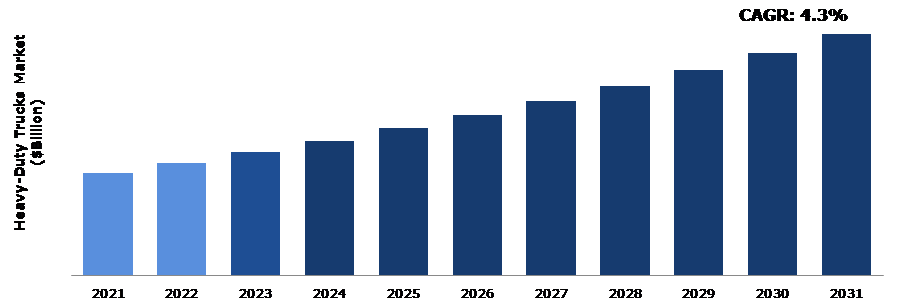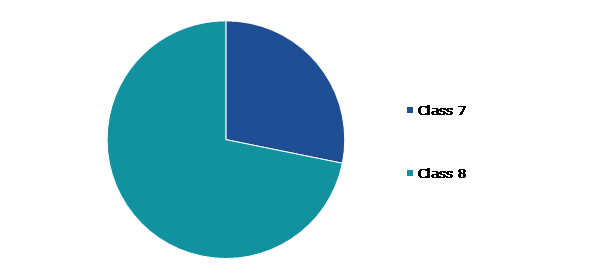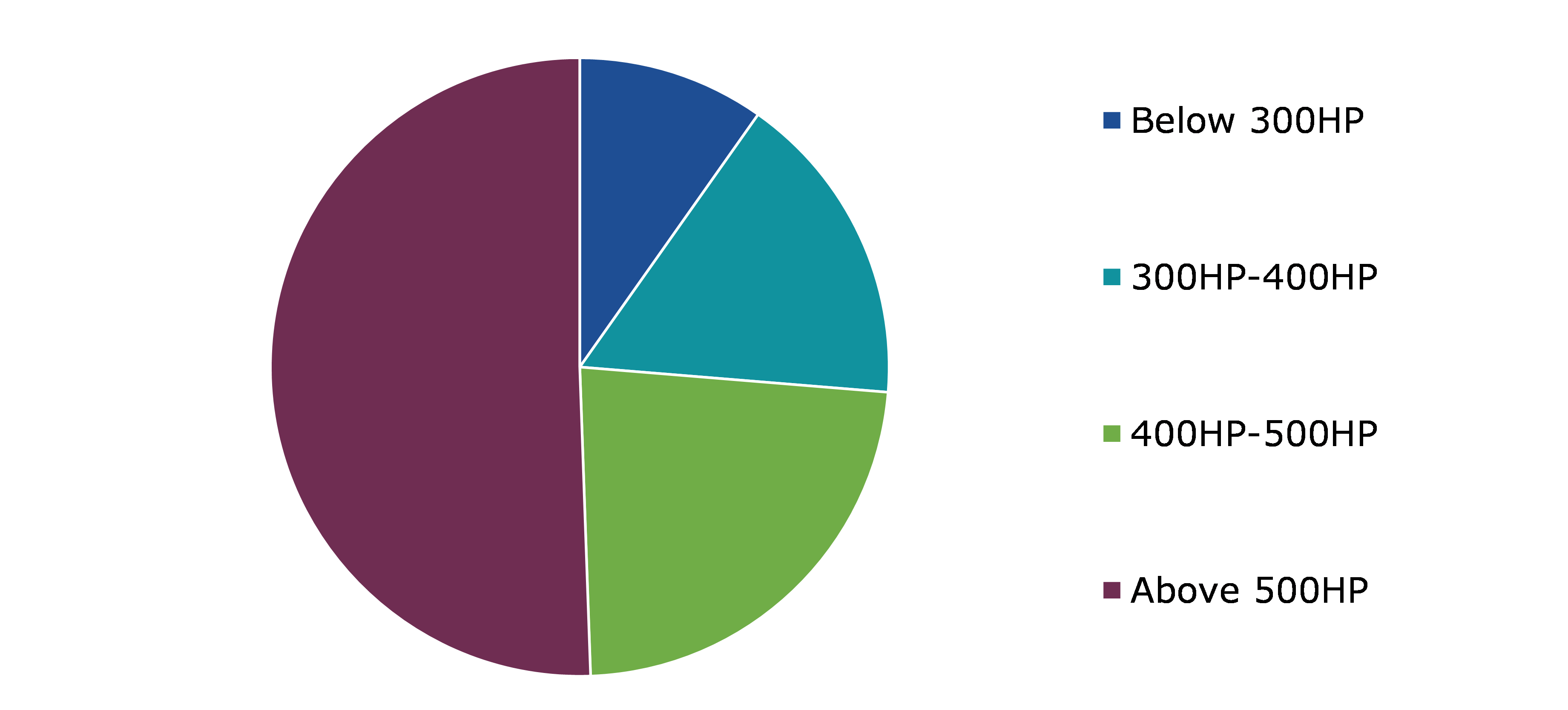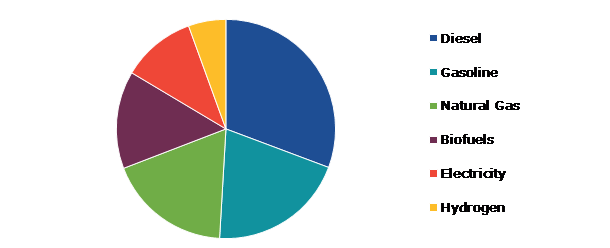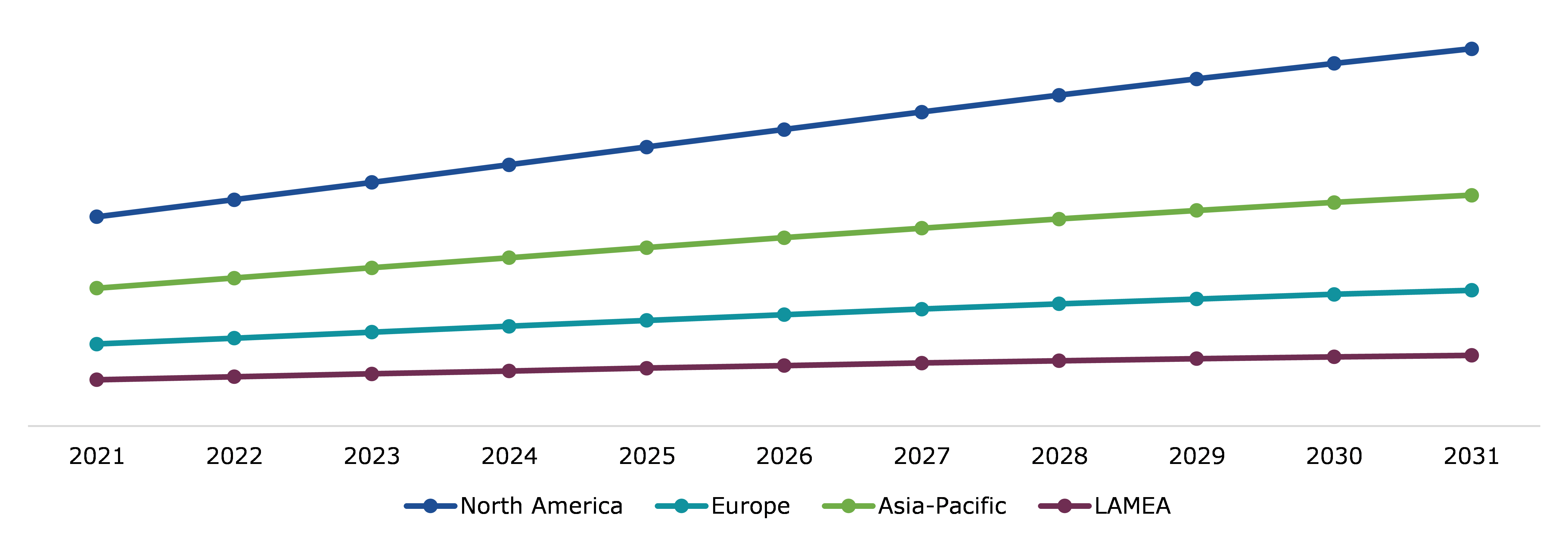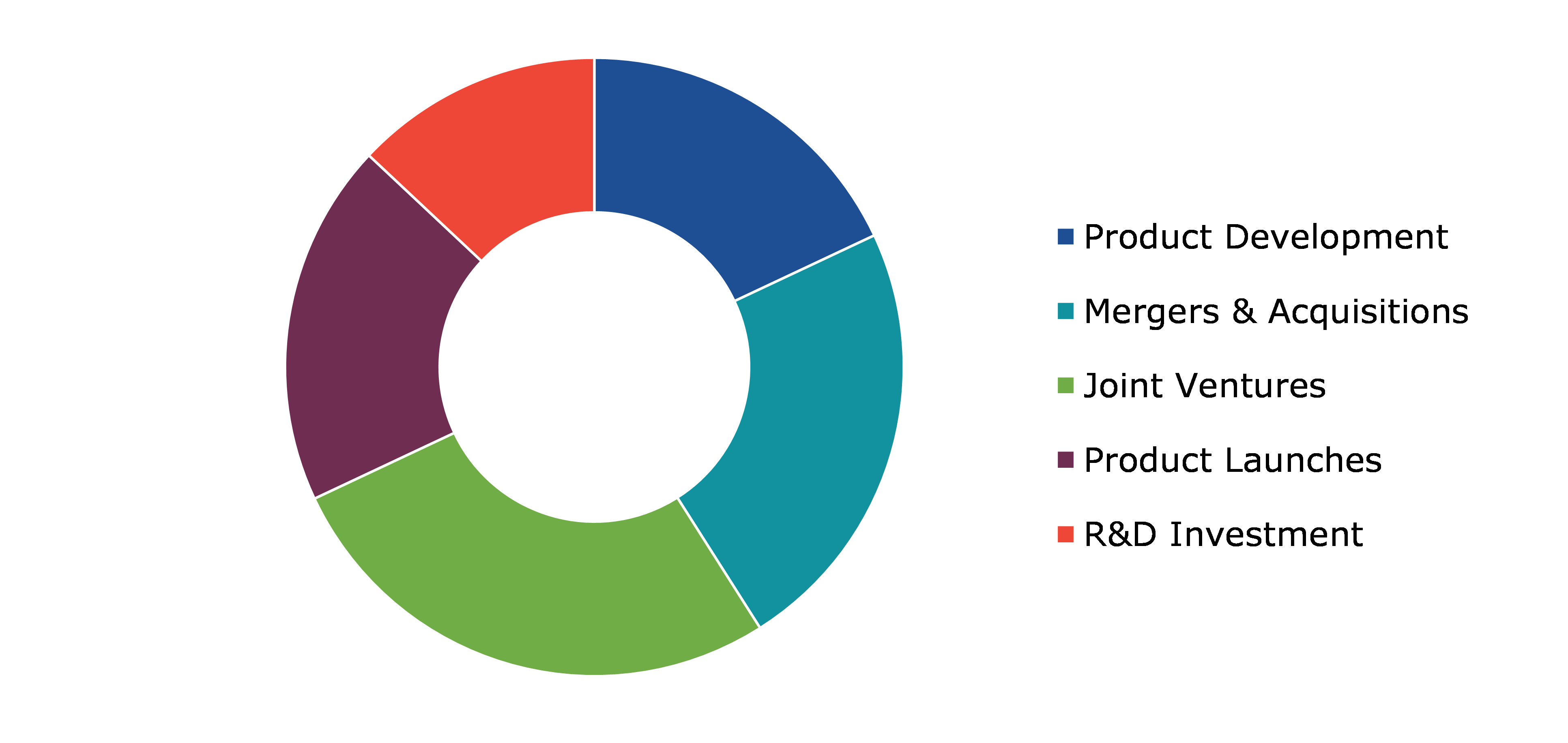Heavy-Duty Trucks Market Report
RA02974
Heavy-Duty Trucks Market by Class (Class 7 and Class 8), Horsepower (Below 300HP, 300HP-400HP, 400HP-500HP, and Above 500HP), Fuel Type (Diesel, Gasoline, Natural Gas, Biofuels, Electricity, and Hydrogen), and Region (North America, Europe, Asia-Pacific, and LAMEA): Global Opportunity Analysis and Industry Forecast 2022–2031
Global Heavy-Duty Trucks Market
The Global Heavy-Duty Trucks Market Size was valued at $357.7 billion in 2021 and is anticipated to reach $538.2 billion by 2031, growing at a CAGR of 4.3% from 2021 to 2031.
Global Heavy-Duty Trucks Market Synopsis
Heavy-duty trucks comprise both single-unit and combined tractor-trailer or tractor-semitrailer vehicles and have a gross vehicle weight of 10,000 pounds or more. With the introduction of new models and cutting-edge technologies in heavy-duty vehicles, the global road transportation market is rapidly evolving. A heavy-duty vehicle is an ideal option for material and goods pickups. The heavy-duty trucks are multipurpose vehicles that are utilized for flatbed trailers, long haul distribution, tippers for mining & construction, and tractor trailers for moving over-dimensioned cargo. The increased need for heavy-duty trucks for goods transportation drives the market growth. Heavy-duty trucks are usually more expensive than their light-duty counterparts. In addition, when compared to conventional vehicles, the cost of purchasing heavy-duty trucks is considerably higher. All these factors are anticipated to hinder the heavy-duty trucks market growth.
In recent years, powerful engines have become standard equipment for heavy commercial trucks. The cost of an engine rises proportionally to its size and capacity; however, the development of a diesel engine is one of the most expensive parts of a vehicle in terms of time and money. The current driveline of a car can be hybridized to increase vehicle performance as opposed to changing the engine for a bigger one. In addition to improving performance, hybridization can help lower fuel consumption and emission levels. During their operational lives, heavy commercial trucks travel relatively great distances, contributing significantly to overall fuel consumption.
The industry players are investing a lot of effort in the R&D of smart and unique strategies to sustain their growth in the market. These strategies include product launches, mergers & acquisitions, collaborations, partnerships, and refurbishing of existing technology. For instance, in September 2022, Volvo Trucks started the production of the electric variants of its heavy-duty truck lineup, which includes the Volvo FH, Volvo FM, and Volvo FMX. These trucks have a maximum operating weight of 44 tons.
According to regional heavy-duty trucks market analysis, the Asia-Pacific heavy-duty trucks market accounted for $ 123.2 billion in 2021 and is predicted to grow with a CAGR of 5.1% in the projected timeframe.
Heavy-Duty Trucks Market Overview
Heavy Duty trucks are fundamental for any business majorly construction, mining, and infrastructure development. Several countries such as China, India, and other European nations are constantly passing regulations in order to maintain the emission and decrease the greenhouse gases resealed by these trucks. In order to overcome these issues, companies are constantly working on developing electric powered heavy-duty trucks market.
COVID-19 Impact on Global Heavy-Duty Trucks Market
The COVID-19 pandemic has created several challenges that have seriously affected the growth of the heavy-duty trucks market. Tight containment measures, including social segregation, remote labor, and the closure of some manufacturing units were implemented as a result of the pandemic to handle the disease. Supply chain issues brought on by such lockdown norms affected a number of industries, notably the manufacturing of large vehicles. Owing to the COVID-19 outbreak, the transportation sector was shut down completely, creating significant challenges for manufacturing and freight enterprises to deliver their products from one place to another. Manufacturing of heavy-duty vehicles declined as a result of substantial interruptions to the world's supply chain and logistics networks during the pandemic. However, the sector is anticipated to grow during the forecast period.
Rise in the Demand for Event Management Business to Drive the Market Growth
To reduce the carbon emissions produced by the combustion of diesel fuel and to combat greenhouse gas emissions, governments throughout the world are putting pressure on automakers to invest in the development of electric trucks. Governments are promoting the development of battery electric trucks through programs and hope to spur the market's expansion. Globally, governments are currently providing tax breaks and other incentives to promote the purchase of electric vehicles. In addition, in a few nations, electric vehicles are exempt from paying tolls on highways. For instance, the Indian government wants to hasten the adoption of electric vehicles by reducing the Goods and Services Tax (GST) on them from 12% to 5%. These factors are expected to drive the global heavy duty trucks market.
High Cost of the Trucks is anticipated to hamper the market growth
The procurement cost of the heavy-duty trucks is much higher when compared to the traditional trucks. Moreover, the maintenance cost is also higher. These above-mentioned factors are anticipated to hamper the global heavy-duty trucks market.
Increase in Use of Advance Technology in Heavy-Duty Trucks to Drive Excellent Opportunity
Transportation advancements, including the introduction of GPS tracking and ADAs features, as well as expansion in the logistics industry, all contribute to the growth of urbanization and industrialization, which drives the heavy-duty trucks market growth. The development of hybrid and electric heavy-duty trucks is projected to be the most important category and the most followed trend in the heavy-duty truck industry. To capitalize on market demand, many manufacturers and companies are producing electric-powered vehicles and hybrid heavy-duty truck market. These above-mentioned factors are anticipated to boost the global heavy-duty trucks market size.
Global Heavy-Duty Trucks Market, By Class
By class, the market is bifurcated into class 7 and class 8. The class 8 segment accounted for the dominant market share in 2021.
Global Heavy-Duty Trucks Market Share, By Class, 2021
Source: Research Dive Analysis
By class, the class 8 segment dominated the market in 2021. Owing to improved long-distance performance and the development of new models, Class 8 heavy-duty trucks shows strong growth potential in the heavy-duty truck market. Modern technologies such as navigation systems, advanced driver assistance systems, and intelligent driver information systems are being added by manufacturers to newer trucks. The increase in use of class 8 trucks by mining industry and rise in funding for the creation of cutting-edge trucks are expected to fuel market expansion. These are anticipated to be the major factors fueling the heavy-duty trucks market size.
Global Heavy-Duty Trucks Market, by Horsepower
By horsepower, the market has been categorized into below 300HP, 300HP-400HP, 400HP-500HP, and above 500HP. Among these, above 500HP held the highest market share in 2021 and is anticipated to continue its dominance during the forecast period.
Global Heavy-Duty Trucks Market Trends, By Horsepower, 2021
Source: Research Dive Analysis
By horsepower, the above 500HP segment dominated the global heavy-duty truck market share in 2021. In terms of horsepower, heavy-duty trucks with more than 500HP experience strong demand due to the vehicles' remarkable load-carrying capacities and range of terrain compatibility. The trucks with low horsepower compared to 500HP find it more difficult to navigate difficult terrain due to natural variables such as poor oxygen availability at higher elevations and harsh temperatures that affect the engine's capacity to generate power.
Global Heavy-Duty Trucks Market, by Fuel Type
On the basis of fuel type, the global heavy-duty trucks market has been fragmented into diesel, gasoline, natural gas, biofuels, electricity, and hydrogen. Among these, the diesel segment held the highest market share in 2021 and is anticipated to continue its dominance during the forecast period.
Global Heavy-Duty Trucks Market Size, By Fuel Type, 2021
Source: Research Dive Analysis
By fuel type, the diesel segment dominated the global heavy-duty trucks market share in 2021. Diesel engines are the most preferred option for heavy-duty truck applications as these engines perform better than gas engines in many areas. Diesel is a safer fuel choice for commercial vehicles with larger fuel tanks since it is far less combustible than gasoline. Diesel engines can accept other fuels and fuel blends with minimal modification, in contrast to gasoline engines that require significant alterations to run different fuel types. Moreover, diesel fuel as a fuel for transportation offers a variety of performance, efficiency, and safety benefits. In addition, diesel fuel offers more useable energy per unit of volume than other liquid fuels due to its higher energy density.
Global Heavy-Duty Trucks Market, Regional Insights
The heavy-duty trucks market analysis was investigated across North America, Europe, Asia-Pacific, and LAMEA.
Global Heavy-Duty Trucks Market Size & Forecast, by region, 2022-2031 (USD Billion)
Source: Research Dive Analysis
The Market for Heavy-Duty Trucks in Asia-Pacific is the Most Dominant
By region, Asia-Pacific dominated the global market in 2021. The transportation business is under pressure to ensure that more commodities and products reach an increasing number of end consumers, with expediency, economy, and environmental concerns all at the forefront. With rapid urbanization, population growth, the expansion of e-commerce, and rising income levels, there is a rising demand for heavy-duty trucks for the transportation of commodities. According to NITI Ayog’s published report in September 2022, by 2050, it is anticipated that heavy-duty trucks will carry almost 8.4 trillion ton-km of long-haul freight, increasing their demand share of road freight travel to 83%. National Institution for Transforming India (NITI) Ayog has the twin mandate to oversee the adoption and monitoring of the Sustainable Development Goals in the country and promote competitive and cooperative federalism among States and the Unreserved Ticketing System. The number of trucks traveling on Indian roads and highways is anticipated to be more than triple, from 4 billion to 17 billion by 2050 as road freight transport continues to expand.
Competitive Scenario in the Global Heavy-Duty Trucks Market
Product launches, business expansions, and technological advancements are common strategies followed by major market players. For instance, in September 2022, Volvo Trucks started the production of the electric variants of its heavy-duty truck lineup, which includes the Volvo FH, Volvo FM, and Volvo FMX. These trucks have a maximum operating weight of 44 tonnes.
Source: Research Dive Analysis
Some of the leading heavy-duty trucks market players are Daimler, Dongfeng, Eicher Motors Limited, Fiat Chrysler Automobiles, Ford Motor Company, Freightliner, General Motors, Kenworth, Navistar, and Nissan. These players are constantly taking various initiatives such as partnership and acquisitions to continue their dominance.
| Aspect | Particulars |
| Historical Market Estimations | 2020 |
| Base Year for Market Estimation | 2021 |
| Forecast Timeline for Market Projection | 2022-2031 |
| Regional Scope | North America, Europe, Asia-Pacific, and LAMEA |
| Segmentation by Class |
|
| Segmentation by Horsepower |
|
| Segmentation by Fuel Type |
|
| Key Companies Profiled |
|
Q1. What is the size of the global heavy-duty trucks market?
A. The size of the global heavy-duty trucks market was over $357.7 billion in 2021 and is projected to reach $538.2 billion by 2031.
Q2. Which are the major companies in the heavy-duty trucks market?
A. Daimler, Dongfeng, and Eicher Motors Limited are some of the major players operating in the heavy-duty trucks market.
Q3. Which region possesses greater investment opportunities in the near future?
A. Asia-Pacific possesses greater investment opportunities for investors to witness the most promising growth in the future.
Q4. What is expected to be the growth rate of the Asia-Pacific heavy-duty trucks market?
A. Asia-Pacific heavy-duty trucks market is anticipated to grow at 5.1% CAGR during the forecast period.
Q5. What are the strategies opted by the leading players in this market?
A. Product launch, business expansion, and product innovation are the key strategies opted by the operating companies in this market.
Q6. Which companies are investing more on R&D practices?
A. General Motors and Kenworth are investing more on R&D activities for developing new products and technologies.
1.Research Methodology
1.1.Desk Research
1.2.Real time insights and validation
1.3.Forecast model
1.4.Assumptions and forecast parameters
1.5.Market size estimation
1.5.1.Top-down approach
1.5.2.Bottom-up approach
2.Report Scope
2.1.Market definition
2.2.Key objectives of the study
2.3.Report overview
2.4.Market segmentation
2.5.Overview of the impact of COVID-19 on Global heavy-duty trucks market
3.Executive Summary
4.Market Overview
4.1.Introduction
4.2.Growth impact forces
4.2.1.Drivers
4.2.2.Restraints
4.2.3.Opportunities
4.3.Market value chain analysis
4.3.1.List of raw material suppliers
4.3.2.List of manufacturers
4.3.3.List of distributors
4.4.Innovation & sustainability matrices
4.4.1.Technology matrix
4.4.2.Regulatory matrix
4.5.Porter’s five forces analysis
4.5.1.Bargaining power of suppliers
4.5.2.Bargaining power of consumers
4.5.3.Threat of substitutes
4.5.4.Threat of new entrants
4.5.5.Competitive rivalry intensity
4.6.PESTLE analysis
4.6.1.Political
4.6.2.Economical
4.6.3.Social
4.6.4.Technological
4.6.5.Environmental
4.7.Impact of COVID-19 on heavy-duty trucks market
4.7.1.Pre-covid market scenario
4.7.2.Post-covid market scenario
5.Heavy-Duty Trucks Market Analysis, by Class
5.1.Overview
5.2.Class-7
5.2.1.Definition, key trends, growth factors, and opportunities
5.2.2.Market size analysis, by region, 2021-2031
5.2.3.Market share analysis, by country, 2021-2031
5.3.Class-8
5.3.1.Definition, key trends, growth factors, and opportunities
5.3.2.Market size analysis, by region, 2021-2031
5.3.3.Market share analysis, by country, 2021-2031
5.4.Research Dive Exclusive Insights
5.4.1.Market attractiveness
5.4.2.Competition heatmap
6.Heavy-Duty Trucks Market Analysis, by Horsepower
6.1.Below 300HP
6.1.1.Definition, key trends, growth factors, and opportunities
6.1.2.Market size analysis, by region, 2021-2031
6.1.3.Market share analysis, by country, 2021-2031
6.2.300HP-400HP
6.2.1.Definition, key trends, growth factors, and opportunities
6.2.2.Market size analysis, by region, 2021-2031
6.2.3.Market share analysis, by country, 2021-2031
6.3.400HP-500HP
6.3.1.Definition, key trends, growth factors, and opportunities
6.3.2.Market size analysis, by region, 2021-2031
6.3.3.Market share analysis, by country, 2021-2031
6.4.Above 500HP
6.4.1.Definition, key trends, growth factors, and opportunities
6.4.2.Market size analysis, by region, 2021-2031
6.4.3.Market share analysis, by country, 2021-2031
6.5.Research Dive Exclusive Insights
6.5.1.Market attractiveness
6.5.2.Competition heatmap
7.Heavy-Duty Trucks Market Analysis, by Fuel Type
7.1.Diesel
7.1.1.Definition, key trends, growth factors, and opportunities
7.1.2.Market size analysis, by region, 2021-2031
7.1.3.Market share analysis, by country, 2021-2031
7.2.Gasoline
7.2.1.Definition, key trends, growth factors, and opportunities
7.2.2.Market size analysis, by region, 2021-2031
7.2.3.Market share analysis, by country, 2021-2031
7.3.Natural Gas
7.3.1.Definition, key trends, growth factors, and opportunities
7.3.2.Market size analysis, by region, 2021-2031
7.3.3.Market share analysis, by country, 2021-2031
7.4.Biofuels
7.4.1.Definition, key trends, growth factors, and opportunities
7.4.2.Market size analysis, by region, 2021-2031
7.4.3.Market share analysis, by country, 2021-2031
7.5.Electricity
7.5.1.Definition, key trends, growth factors, and opportunities
7.5.2.Market size analysis, by region, 2021-2031
7.5.3.Market share analysis, by country, 2021-2031
7.6.Hydrogen
7.6.1.Definition, key trends, growth factors, and opportunities
7.6.2.Market size analysis, by region, 2021-2031
7.6.3.Market share analysis, by country, 2021-2031
7.7.Research Dive Exclusive Insights
7.7.1.Market attractiveness
7.7.2.Competition heatmap
8.Heavy-Duty Trucks Market, by region
8.1.North America
8.1.1.U.S.
8.1.1.1.Market size analysis, by Class, 2021-2031
8.1.1.2.Market size analysis, by Horsepower, 2021-2031
8.1.1.3.Market size analysis, by Fuel Type, 2021-2031
8.1.2.Canada
8.1.2.1.Market size analysis, by Class, 2021-2031
8.1.2.2.Market size analysis, by Horsepower, 2021-2031
8.1.2.3.Market size analysis, by Fuel Type, 2021-2031
8.1.2.4.Mexico
8.1.2.5.Market size analysis, by Class, 2021-2031
8.1.2.6.Market size analysis, by Horsepower, 2021-2031
8.1.2.7.Market size analysis, by Fuel Type, 2021-2031
8.1.3.Research Dive Exclusive Insights
8.1.3.1.Market attractiveness
8.1.3.2.Competition heatmap
8.2.Europe
8.2.1.Germany
8.2.1.1.Market size analysis, by Class, 2021-2031
8.2.1.2.Market size analysis, by Horsepower, 2021-2031
8.2.1.3.Market size analysis, by Fuel Type, 2021-2031
8.2.2.UK
8.2.2.1.Market size analysis, by Class, 2021-2031
8.2.2.2.Market size analysis, by Horsepower, 2021-2031
8.2.2.3.Market size analysis, by Fuel Type, 2021-2031
8.2.3.France
8.2.3.1.Market size analysis, by Class, 2021-2031
8.2.3.2.Market size analysis, by Horsepower, 2021-2031
8.2.3.3.Market size analysis, by Fuel Type, 2021-2031
8.2.4.Spain
8.2.4.1.Market size analysis, by Class, 2021-2031
8.2.4.2.Market size analysis, by Horsepower, 2021-2031
8.2.4.3.Market size analysis, by Fuel Type, 2021-2031
8.2.5.Italy
8.2.5.1.Market size analysis, by Class, 2021-2031
8.2.5.2.Market size analysis, by Horsepower, 2021-2031
8.2.5.3.Market size analysis, by Fuel Type, 2021-2031
8.2.6.Rest of Europe
8.2.6.1.Market size analysis, by Class, 2021-2031
8.2.6.2.Market size analysis, by Horsepower, 2021-2031
8.2.6.3.Market size analysis, by Fuel Type, 2021-2031
8.2.7.Research Dive Exclusive Insights
8.2.7.1.Market attractiveness
8.2.7.2.Competition heatmap
8.3.Asia Pacific
8.3.1.China
8.3.1.1.Market size analysis, by Class, 2021-2031
8.3.1.2.Market size analysis, by Horsepower, 2021-2031
8.3.1.3.Market size analysis, by Fuel Type, 2021-2031
8.3.2.Japan
8.3.2.1.Market size analysis, by Class, 2021-2031
8.3.2.2.Market size analysis, by Horsepower, 2021-2031
8.3.2.3.Market size analysis, by Fuel Type, 2021-2031
8.3.3.India
8.3.3.1.Market size analysis, by Class, 2021-2031
8.3.3.2.Market size analysis, by Horsepower, 2021-2031
8.3.3.3.Market size analysis, by Fuel Type, 2021-2031
8.3.4.Australia
8.3.4.1.Market size analysis, by Class, 2021-2031
8.3.4.2.Market size analysis, by Horsepower, 2021-2031
8.3.4.3.Market size analysis, by Fuel Type, 2021-2031
8.3.5.South Korea
8.3.5.1.Market size analysis, by Class, 2021-2031
8.3.5.2.Market size analysis, by Horsepower, 2021-2031
8.3.5.3.Market size analysis, by Fuel Type, 2021-2031
8.3.6.Rest of Asia Pacific
8.3.6.1.Market size analysis, by Class, 2021-2031
8.3.6.2.Market size analysis, by Horsepower, 2021-2031
8.3.6.3.Market size analysis, by Fuel Type, 2021-2031
8.3.7.Research Dive Exclusive Insights
8.3.7.1.Market attractiveness
8.3.7.2.Competition heatmap
8.4.LAMEA
8.4.1.Brazil
8.4.1.1.Market size analysis, by Class, 2021-2031
8.4.1.2.Market size analysis, by Horsepower, 2021-2031
8.4.1.3.Market size analysis, by Fuel Type, 2021-2031
8.4.2.Saudi Arabia
8.4.2.1.Market size analysis, by Class, 2021-2031
8.4.2.2.Market size analysis, by Horsepower, 2021-2031
8.4.2.3.Market size analysis, by Fuel Type, 2021-2031
8.4.3.UAE
8.4.3.1.Market size analysis, by Class, 2021-2031
8.4.3.2.Market size analysis, by Horsepower, 2021-2031
8.4.3.3.Market size analysis, by Fuel Type, 2021-2031
8.4.4.South Africa
8.4.4.1.Market size analysis, by Class, 2021-2031
8.4.4.2.Market size analysis, by Horsepower, 2021-2031
8.4.4.3.Market size analysis, by Fuel Type, 2021-2031
8.4.5.Rest of LAMEA
8.4.5.1.Market size analysis, by Class, 2021-2031
8.4.5.2.Market size analysis, by Horsepower, 2021-2031
8.4.5.3.Market size analysis, by Fuel Type, 2021-2031
8.4.6.Research Dive Exclusive Insights
8.4.6.1.Market attractiveness
8.4.6.2.Competition heatmap
9.Competitive Landscape
9.1.Top winning strategies, 2021
9.1.1.By strategy
9.1.2.By year
9.2.Strategic overview
9.3.Market share analysis, 2021
10.Company Profiles
10.1.Daimler
10.1.1.Overview
10.1.2.Business segments
10.1.3.Product portfolio
10.1.4.Financial performance
10.1.5.Recent developments
10.1.6.SWOT analysis
10.2.Dongfeng
10.2.1.Overview
10.2.2.Business segments
10.2.3.Product portfolio
10.2.4.Financial performance
10.2.5.Recent developments
10.2.6.SWOT analysis
10.3.Eicher Motors Limited
10.3.1.Overview
10.3.2.Business segments
10.3.3.Product portfolio
10.3.4.Financial performance
10.3.5.Recent developments
10.3.6.SWOT analysis
10.4.Fiat Chrysler Automobiles
10.4.1.Overview
10.4.2.Business segments
10.4.3.Product portfolio
10.4.4.Financial performance
10.4.5.Recent developments
10.4.6.SWOT analysis
10.5.Ford Motor Company
10.5.1.Overview
10.5.2.Business segments
10.5.3.Product portfolio
10.5.4.Financial performance
10.5.5.Recent developments
10.5.6.SWOT analysis
10.6.Freightliner
10.6.1.Overview
10.6.2.Business segments
10.6.3.Product portfolio
10.6.4.Financial performance
10.6.5.Recent developments
10.6.6.SWOT analysis
10.7.General Motors
10.7.1.Overview
10.7.2.Business segments
10.7.3.Product portfolio
10.7.4.Financial performance
10.7.5.Recent developments
10.7.6.SWOT analysis
10.8.Kenworth
10.8.1.Overview
10.8.2.Business segments
10.8.3.Product portfolio
10.8.4.Financial performance
10.8.5.Recent developments
10.8.6.SWOT analysis
10.9.Navistar
10.9.1.Overview
10.9.2.Business segments
10.9.3.Product portfolio
10.9.4.Financial performance
10.9.5.Recent developments
10.9.6.SWOT analysis
10.10.Nissan
10.10.1.Overview
10.10.2.Business segments
10.10.3.Product portfolio
10.10.4.Financial performance
10.10.5.Recent developments
10.10.6.SWOT analysis
Heavy-duty trucks, also known as commercial trucks, are the backbone of the transportation industry. These vehicles are classified based on their weight and carrying capacity. They are divided into several categories including class 7 and class 8 trucks, tractor-trailer trucks, 18-wheeler trucks, dump trucks, concrete mixers, and many others, each with their specific uses. These vehicles can carry heavy loads of up to 80,000 pounds. Heavy-duty vehicles are widely used across various industries such as construction, mining, agriculture, pharmaceutical, and logistics. Nowadays, manufacturers are investing in new technologies to reduce greenhouse emissions and create more sustainable options for the future.
Forecast Analysis of the Global Heavy-Duty Trucks Market
With the increasing pressure on automakers globally to invest in the development of electric trucks by governments of many nations, the heavy-duty truck market is predicted to experience progressive growth over the estimated timeframe. Besides, the supportive initiatives taken by the government of several nations for promoting the production of electric vehicles, such as the exemption of paying tolls on highways are expected to bolster the growth of the market during the analysis period. Moreover, the growing incorporation of advanced technology in heavy-duty trucks such as the adoption of GPS tracking and ADAs features is expected to create huge growth opportunities for the market throughout the forecast period. However, the higher maintenance course of heavy-duty trucks may hamper the growth of the market over the estimated timeframe.
According to the report published by Research Dive, the global heavy-duty trucks market is anticipated to garner $538.2 billion in revenue and grow at a CAGR of 4.3% over the analysis timeframe from 2022 to 2031. The major players of the market include Nissan, Daimler, Dongfeng, Navistar, Eicher Motors Limited, Kenworth, Fiat Chrysler Automobiles, General Motors, Ford Motor Company, Freightliner, and many more.
Heavy-Duty Trucks Market Trends & Developments
The key companies operating in the industry are adopting various growth strategies & business tactics such as partnerships, collaborations, mergers & acquisitions, and launches to maintain a robust position in the overall market, which is subsequently helping the global heavy-duty trucks market to grow exponentially. For instance:
- In March 2023, TruckPro, LLC., one of the largest independent distributors of heavy-duty trucks announced its acquisition of Drivelines N.W. Inc., a renowned driveline repair, fabrication, and parts provider in Washington. With this acquisition, the companies aimed to expand their businesses in Seattle and surrounding Puget Sound market.
- In September 2022, Volvo Trucks, a truck manufacturing division of Volvo, announced the launch of its series production of heavy-duty trucks, namely, Volvo FH, Volvo FM, and Volvo FMX. These trucks are designed to operate with a total weight of 44 tons. With this launch, Volvo has six electric truck models in series production globally.
- In December 2022, Sensible 4, an automated driving technology company announced its partnership with UD Trucks, a Japanese company that manufactures and sells diesel trucks, buses, and special-purpose vehicles. With this partnership, the companies aimed to automate a heavy-duty truck by enabling autonomous transportation and dumping of materials at the live industrial site in Japan.
Most Productive Region
The Asia-Pacific region of the heavy-duty trucks market generated the maximum share in 2021 and is expected to have the fastest growth over the forecast period. The rising demand for heavy-duty trucks for the transportation of e-commerce, growing disposable income among individuals of this region, and the rapid urbanization in this region are the major factors expected to boost the regional growth of the market throughout the estimated period.
Covid-19 Impact on the Heavy-Duty Trucks Market
The rise of the novel coronavirus has devasted several industries, it has also badly affected the heavy-duty trucks market. This is mainly due to containment measures, remote labor, the closure of manufacturing units, and social-distancing norms during the pandemic. Moreover, supply chain issues and strict transportation regulations have created severe challenges before the production of heavy-duty trucks. All these factors have decreased the growth of the market over the crisis period.
Personalize this research
- Triangulate with your own data
- Request your format and definition
- Get a deeper dive on a specific application, geography, customer or competitor
- + 1-888-961-4454 Toll - Free
- support@researchdive.com

